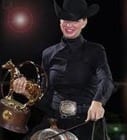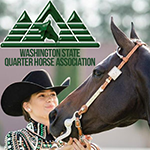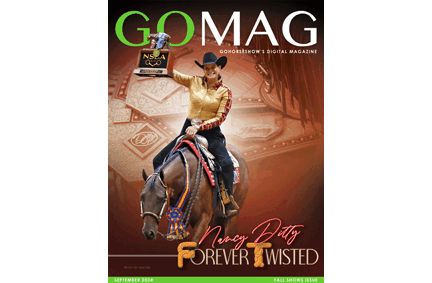AQHA judge, GoHorseShow.com reporter, and 18-time All-American Quarter Horse Congress winner, Laura Gilmer discusses some of the important parts of the Congress showmanship, horsemanship, and equitation patterns. Second up in the series: Breaking Down the Congress Patterns: Horsemanship.
This article will concentrate on the Amateur and 15-18 patterns since they are the most difficult (and the same) and have several of the same maneuvers as the lower divisions. Trotting square corners seem to be very popular this year and shows up in the showmanship and equitation patterns. In the horsemanship, jogging to an extended trot, extended lope to a slow lope, and extended lope to a stop are common maneuvers in many of the patterns.
Several Amateurs I spoke with were excited to learn that they are showing the showmanship and horsemanship in the Celeste Arena this year instead of the Coliseum which they have done for the past few years, or the tiny Cooper Arena, home of the 2006 Amateur Showmanship.
Horsemanship
Click here to view pattern in separate window
Patterns courtesy of HorseShowPatterns.com
The biggest recommendation I can have for the riders showing in the horsemanship is to show obvious differences in your speed. Some riders I have judged are too afraid to increase their speed, or they start off in a 4-beat crawl of a lope and then increase their speed where their increased speed should have been the speed they started their pattern. You need to ride your horse forward in this type of horsemanship pattern while maintaining contact and constant communication with your horse. I do not like to see draped reins in the horsemanship regardless if your horse can pull it off or not. In my personal opinion, the rider does not look connected to the horse, and I do not believe it is appropriate in this class.
As far as attire, I prefer solid colored shirts and chaps that don’t break up the rider’s profile. A few months ago youth exhibitor, Carey Nowacek, won the AQHYA World Championship in Horsemanship wearing a button down tailored black shirt. Her outfit was not fancy but it showed off her gorgeous profile. While many of us are not as fortunate to have long legs like Nowacek, wearing the same color will help lengthen your profile and give the illusion that you are taller. While I don’t mind a little bling on the horsemanship shirts, it should not distract from the overall picture. Please, no fringe in horsemanship!
Many competitors are very excited about the horsemanship patterns this year. This year’s 15-18 and Amateur Horsemanship pattern looks like a challenging and exciting pattern. “I love love love the pattern this year!” says Peskin, who placed 8th at the Congress in the Amateur Horsemanship last year. “I am super excited to show that pattern. It looks easier than I think it will ride, but it’s all about thinking through the steps and having good spacial awareness in the pen. The thing with the Congress is that you can over prep. You need to balance knowing how to get through the pieces, put it all together so it flows, but not have it get stale or have your horse dull to the pattern. There’s something to be said for having your horse still engaged in it with you.”
 Here is my break down of the pattern. Be Ready at A
Here is my break down of the pattern. Be Ready at A
1. The rider starts the pattern at a jog, then increases to an extended jog. The pattern begins soft and then keeps increasing speed throughout the pattern. The rider needs to show an obvious difference in speed. Do not bob your head and chin when you are extending your trot. It takes away from your appearance and will negatively effect your score. Try to make the increase gradual and smooth rather than slow and then automatically busting out to an extended trot.
2. From the extended trot, the rider is asked to stop, and turn 1 and 1/4 right. The stop from the extended trot needs to be smooth and the rider needs to go immediately into their turn to the right. In my opinion, the turn needs to be fast but accurate. To be competitive at the Congress, the rider’s horse needs to be trained to complete a fast spin with little hand movement or resistance from the horse. Some people may argue that the horse’s lack of training is being held against the rider–while that may seem unfair to some, under my card, the rider and the horse that have all the necessarily skills to perform the ideal pattern will be rewarded.
3. After their turn, the rider must lope right off without any hesitation. Then, the rider will immediately extend the lope on the right lead in a right circle. Just by having the words “immediately” in the written pattern quickly takes the pattern from a soft, flowing pattern to a hard, athletic run, Nowacek says. “It will be quite a challenge to make sure you get a good stop from your extended jog, and have a collected turn so you can get out of there without pausing too long.”
I like to see the exhibitor come right out of the turn like they are doing a rollback in a reining pattern. There needs to be constant movement in the pattern. Someone who hesitates and pauses too long will lose their momentum and the rhythm of the pattern will be disrupted.
4. The pattern calls for a “large FAST” circle, meaning the judges want FAST. As a judge, if I have any thoughts that the rider is going too slow–they will not place on my card. They must go all out and show an extreme difference in their speed. That is what the pattern calls for and the riders that go all out will be rewarded on my card. Of course, this avenue is the riskiest because it is a higher degree of difficulty with a higher likelihood of making a mistake–but their effort and gutsy ride will be rewarded on my card more so than someone who plays it safe.
After the fast circle, the riders are asked to slow to a lope and complete a half circle to the right. According to Nowacek, “This will separate many people because, again, we have to go from a more athletic, tough piece, back to an elegant, slow maneuver.”
While, the pattern calls for a decrease in speed to a lope to complete a half circle. I cannot stress to riders enough that that does not mean to slow down to a four beat crawl of a lope that visually looks unappealing and takes forever for the rider to complete. The lope must still be 3-beat and moving forward. If a rider is loping this slow in the pattern, he/she will be immediately removed from consideration on my card. Also, you must gauge how your horse will handle going from a fast circle to a small slow circle. Some horses get too nervous and can never recover their composure after loping a fast circle, so the rider must know their horse well enough to know how far they can push them.
5. When completing the right half circle, they change leads (simple or flying) and begin to lope a circle to the left. Again, under my card, the rider that has a flying lead change and completes all the necessary skills will be rewarded more than a rider that is equally talented but only completes a simple lead change. The rider must keep enough momentum to have a nice lead change in the exact spot indicated. Some riders get too slow and they end up with a rough, hopping lead change. On the other end of the spectrum, some exhibitors must take care to have adequate communication with their horse before the lead change in order to prevent losing control of their horse and changing either early or late.
6. When starting the circle to the left, the rider does not close the circle but asked to continue to the end of the arena. Make sure you are constantly aware of your surroundings. You need to be constantly looking to where you need to go in this pattern.
7. While continuing to increase the lope speed, the rider is then asked to stop. The rider has to make sure they are in sync with their horse and know what speed is appropriate for them to be able to make a pretty stop from an extended lope. I would recommend horsemanship riders to watch some reining patterns live or on video to see how the successful riders come down from a fast circle to a small circle, and also to see how they increase their speed from a lope to an extended lope to complete their stop. Any horsemanship riders with a reining background will have an advantage executing this pattern.
8. The last element will be a tricky one, Nowacek says. “There are so many things to think about at this point in the pattern. It is the judges last look at us before we leave the arena, and we have to look our best. It will be hard to make sure our body is perfect while attempting to increase speed in a straight line, and even harder to stop from a lope with speed and keep it soft enough so your body looks good through the stop and not rough.”
9. After the final stop, the riders are asked to exit the arena at the jog. In the jog, never quit showing. The rider needs to continue showing until out of the sight of the judges. Sometimes riders get excited and pet their horses before they leave the arena. Don’t do that! It leaves the impression to the judges that you lost your composure before finishing your pattern. So, stay calm, cool, and collected until the very end!
In conclusion, this is the type of pattern for the more experienced riders that have the confidence to bust out the pattern and ride it literally like they are riding a reining pattern. Do not ride this pattern at anytime like you are showing in a Western Pleasure class–you are not on the rail and this is not the time to be tentative or slow.
Good luck to everyone showing in the horsemanship classes at the Congress and remember to not be afraid to GO FOR IT!
Photos courtesy The American Quarter Horse Journal.








